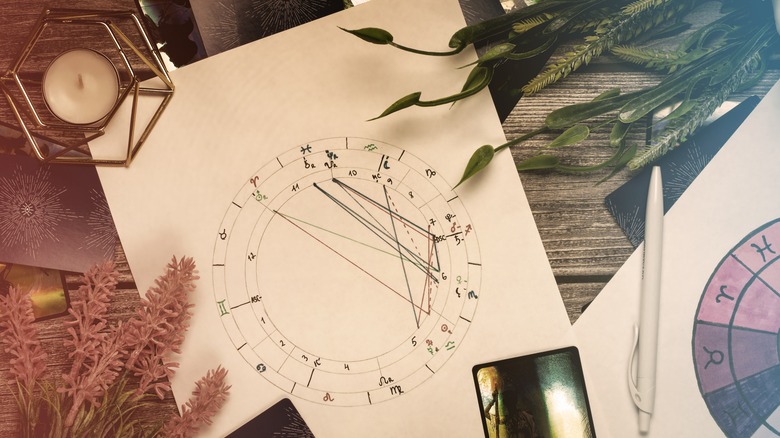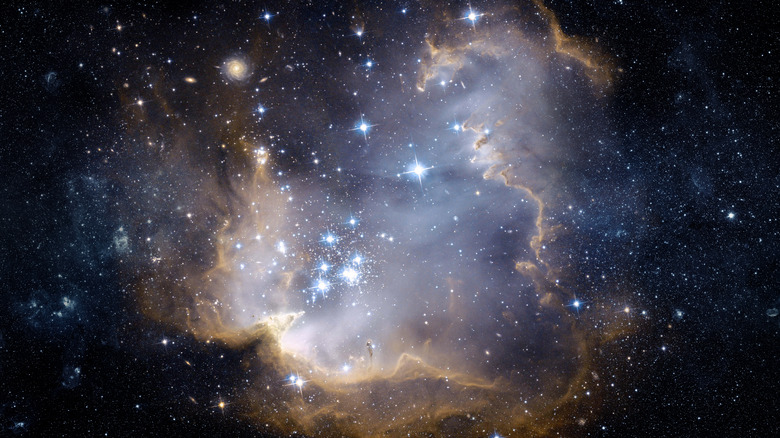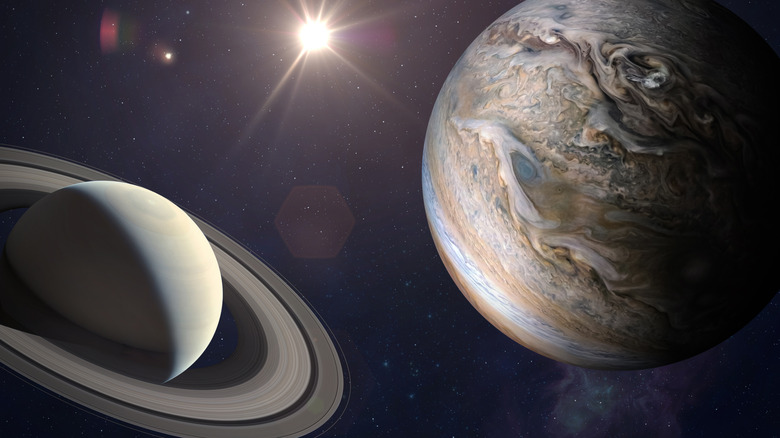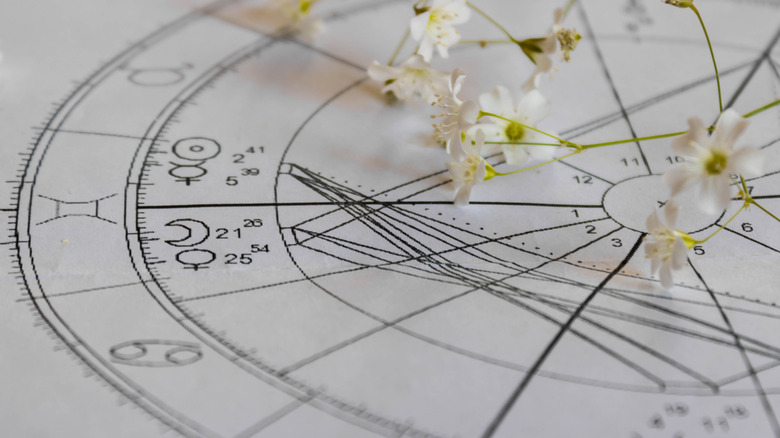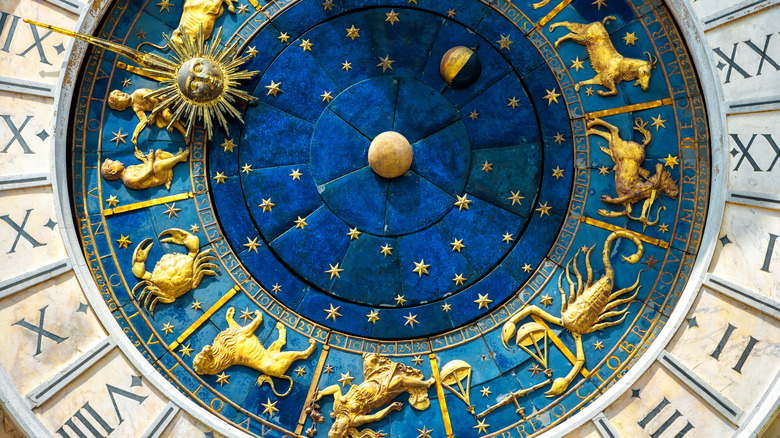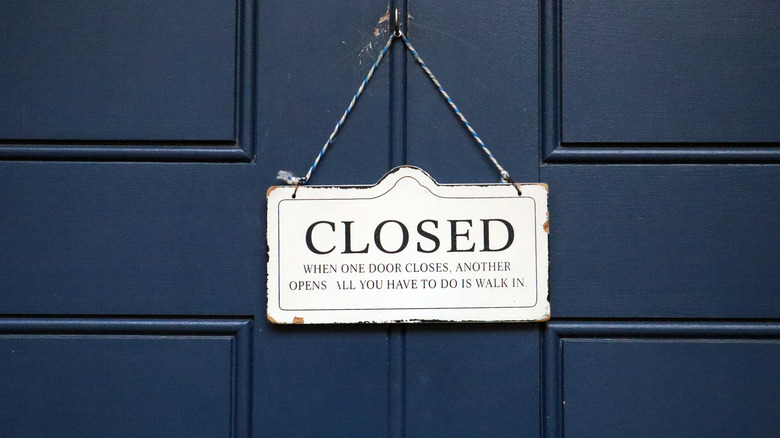Everything You Need To Know About Aspects In Astrology
"What's your sign?" is a popular question among astrology enthusiasts everywhere — but what about the other parts you see in your natal chart? Well, in astrological studies, there is a basic understanding that each individual is not just one zodiac sign. Despite many people oversimplifying the concept of astrology, the practice itself is pretty complex, with tons of intricacies and elaborate details.
Different placements, signs, and configurations can highlight unique pieces by providing more in-depth information on our lives, lessons, and how we react to dilemmas, relationships, and so on. With this in mind, the more specific you get with astrology, the more detailed answers you will find. This logic is also apparent with planetary aspects, an often neglected part of astrology.
"Aspects are basically the connection that two planets are making with one another," Miami-based astrologer Valerie Mesa tells Elite Daily. "It's how the planets are vibing with one another." But as expressed before, astrology can (and does) go much, much deeper than that. So let's talk about planetary aspects, specifically major and minor aspects, along with signs aspects and, most importantly, what they all mean.
The purpose and history behind major aspects
Major planetary aspects, also known as Ptolemaic aspects, deal with the planets, the distance from each other measured in degrees, and their interaction. Like most things in astrology, aspects go back to early civilization. More specifically, the aspects we know today came from Hellenistic tradition in the 1st century BCE.
This method of astrology would be known today as Hellenistic astrology, a blend of Mesopotamian and Egyptian astrology. Astronomers and astrologists from this time viewed and studied the configurations of the planets to develop the concept of aspects. To understand how these planets relate, we can break it down with sun sign compatibility, a more prevalent way to understand aspects that almost everyone understands.
For instance, we know that zodiac signs have friendship compatibility — a general idea that every sign gets along with some more than others. Although this deals with elements associated with each sign, it is also based on the configuration you see on an astrology chart, which can also help decode planetary aspects. Sun signs considered well-suited or compatible are directly across from each other on the wheel.
Conjunctions
One powerful major aspect is conjunction, when two planets are no more than 10 degrees apart from each other. In many cases, it looks like the planets are on top of each other, which is why many astrologers argue it is the strongest aspect. Due to the extreme closeness of the planets, their energies merge and reinforce one another.
"This is very important, as it can change the overall impact of that planet in a person's chart and life," astrologer Kayse Budd tells MindBodyGreen. "An Aries person, for example, with Venus next to their sun, will be profoundly different than an Aries who has Mars next to their sun (or no planets next to their sun)," Budd explains.
Another example is when the sun and Mercury are conjunct, it encourages more self-expression — which makes sense, considering Mercury is the planet of communication. In contrast, Mars and Uranus in conjunction can cause friction or resistance due to Mars's connection with action and Uranus's connection to rebellion. Both examples display how a conjunction can create a favorable or opposing environment.
Trine
The trine aspect is when planets are 120 degrees apart. Astrostyle calls this aspect the "sweet spot," as the planets in a trine are "operating with the same goals, energy, and agenda." Here's a quick tip to visually see a trine quicker: Make note of the elements on an astrological chart. If the planets are in the same element, that indicates that a trine configuration is going on.
Or you may notice that your planets are four signs apart and the same element. This makes for an incredibly harmonious aspect since the planets are working together instead of against each other. Trines give the ability for all-over acceptance — not just for others, but ourselves, too.
Folks with this positive aspect in their natal chart are also known to receive and execute every opportunity that comes their way with ease. It can also enhance the positive characteristics of your sun sign. For instance, if you are a water sign, your sensitivity and empathy towards others will be heightened.
Sextile
"A sextile is a friendly and flirty aspect between signs that are 60 degrees apart," astrologer Lisa Stardust tells Bustle. "Usually, they occur between fire and air signs, and earth and water signs." If you pay close attention to an astrological chart, you will notice that every sign 60 degrees from each other are compatible, so it is fair to think the same thing would occur with the planets.
Not to mention that many associate the sextile with its bigger cousin, trine, which is 120 degrees of distance (double the amount of a sextile). Cafe Astrology describes sextile as having more "oomph" and power behind it and helping us acknowledge our "talents or tendencies" and feel encouraged to develop them further.
Having a sextile configuration present in your natal chart makes it easier to recognize and nurture these natural talents you may possess. Sextiles are a sweet, nurturing, chill aspect that promotes relationship growth and interaction during their configuration. All of this means that if you see a sextile approaching or present in your natal chart, it's definitely good news because it is considered a harmonious aspect!
Square
If you want to understand and learn more about conflicts or points of contention in your life, then the square aspect is definitely something you should look into. This hard aspect, where the planets are 90 degrees apart, can highlight significant areas of potential distress or obstacles to come.
Some would consider this aspect "bad" or negative, but it underlines an excellent time for learning, growing, and broadening our horizons. We often need an external force or inconvenience to move us in the right direction. We can get too comfortable and set roots in our comfort zones when we are meant for more. After all, as humans, we are built to evolve and grow over time. While some consider this aspect scary, it is an excellent time for lessons and breakthroughs to happen.
So if you notice or hear about a square aspect occurring or about to come, keep a clear head and stay mindful of your shortcomings. This aspect is also more challenging for young people — but of course, with more time, experience, and lessons learned, this aspect will become easier to handle.
Opposition
The opposition aspect symbolizes its name exactly. The degree for opposition is 180 degrees, meaning that the planets have to be opposite of each other. With this aspect, you can see it occur between two or more planets. And, like the square, the opposition is complex in nature.
If you look at an astrology chart, each sign opposite of another has a varied mix in compatibility. Those who have this placement in their birth chart constantly look for an identical person to give them validation of their internal struggles — and opposites do attract, even in the zodiac. "Earth signs are opposite water signs, and fire signs are opposite air signs," Kayse Budd tells MindBodyGreen. "This is one reason I think oppositions are a bit easier to manage than squares."
It's advised that during an opposition aspect, you should forgo making any rash decisions, especially if you have to choose or decide between two obscure things. Take your time and consider the pros and cons on both sides. The natural energy of this aspect can cause uncertainty. But as stated before, with patience and a clear head, this aspect can be rewarding and favorable for you and your goals.
What about minor aspects?
The minor aspects, essentially, are other aspects that are not the five aforementioned major ones. Many would think the minor aspects have a lesser influence due to their name and smaller measure, but many modern and experienced astrologers argue that this could not be further from the truth.
In reality, astrology gets more detailed and distinct the more specifics you add to it, and this same logic applies to astrology's minor aspects. The need for more attention to these aspects comes from their late discovery.
It wasn't until hundreds of centuries after the five major aspects were discovered that Johannes Kepler, a German astronomer and astrologer, noted these minor aspects. So why are we discussing or adding them now? In short, they can provide more clarity and detail on particular questions or concerns. It can also lead to a more profound and critical analysis of one's astrological birth chart.
Semi-sextile
As suggested, a semi-sextile represents a part of the sextile aspect. You can see this minor aspect with planets that are 30 degrees apart. Semi-sextile conveys unity and has many characteristics of a sextile major aspect, like pleasant and agreeable happenings. Moreover, the semi-sextile highlights room for growth when working with others.
But on the opposite side, the semi-sextile has been known to cause difficulties. When two signs 30 degrees apart join forces to accomplish a common goal, some sort of tension is bound to surface at one point or another. Astrologers (or you) should look at other parts of your chart to get a comprehensive view of each piece that relates to the other.
Make it your goal to understand the other person's point of view and make sure that you take it into account to have a calm and cohesive collaborative effort with this person. Remember to remain empathic and try to compromise where you can. If you follow this approach, the semisextile won't hit you as hard, and you will gain more experience rather than just hardship.
Semi-square
Like the square, the semi-square is another hard aspect that showcases conflict, stress, or obstacles. The semi-square minor aspect operates when planets are 45 degrees apart (half of the square). Although the planetary energies are less intense than the square, like most minor aspects, the tension it creates is definitely worth noting.
The semi-square aspect provides a great learning opportunity: If you have ever wondered how daily horoscopes gather so much information, even "small" details like minor aspects and nuances in astrology, like this, is how. Although the semi-square likely provides most "bad" news in astrology, if you take the information and remain aware of your shortcomings and room for growth, these times will bring you plenty of rewarding experiences.
When faced with the semi-square, it will be helpful to stop sugarcoating your issues or stress. Even though you may not constantly feel the friction from the semi-square, they can be tricky to handle when that moment comes. So if you find yourself in the middle of a challenging semi-square aspect, understand that it is an opportunity for expansion and learning.
Quintile and bi-quintile
When the planets are 72 and 144 degrees apart, we get quintiles and bi-quintiles, respectively. Quintiles suggest variety, a true sense of self, and the urge to use artistic or creative abilities. Bi-quintiles share very similar qualities, like creativity and ambition. When presented with a quintile, you may find yourself eager and excited to take on a new project or opportunity. This aspect shows much promise and is a positive minor aspect.
During this time, it is ideal to set those dreams into action. Do not be afraid to turn your desires into something more. Remember: You won't reap the benefits of any aspect unless you put the work in to do so. Use this time to plan and execute your visions effectively because this aspect will definitely be in your favor. Don't be afraid to grab opportunities that you would otherwise shy away from for whatever reason.
Quincunx
This minor aspect (also commonly called inconjunct) occurs when the planets are 150 degrees from each other, or the zodiac signs are five signs apart. While it does not have the strongest influence, experts claim it can cause distress or tension in some areas of your life. Due to its effects, this aspect is connected with adjustments in order to create a more fulfilling life as things change.
In regards to meaning, the quincunx brings forth awareness and potential. Oftentimes, you see these connected with two people who must exhibit a sense of self-reflection and growth to move past any tension. This minor aspect also connects to our desires.
For those with quincunx in your birth chart, you may have contradictions with what you want in life. You may feel like you are chill and relaxed sometimes but high-strung in other situations. Give yourself grace if you have quincunx in your natal chart and know you can excel with opposing character traits.
Septile
Septile is a positive aspect but isn't used much by modern practitioners, according to Trusted Astrology. In a nutshell, this minor aspect relates to everything dealing with spirituality, faith, and the divine. It occurs with planets 51 degrees apart and can manifest in multiple ways in our lives.
During this aspect's transit, many may find themselves closer to their faith or have the desire to study it even further. You may even be deeply curious about a different sense of spirituality from your norm. Throughout this time, you will find great comfort in fellow spiritual people.
You may seek them out for a sense of community and for them to validate your new journey. Adding people with a similar quest into your inner circle builds a stable and comforting camaraderie. Those who are not religious may ponder more existential thoughts during this time. Now would be a great time to nail down and search for your life's purpose.
Novile
Novile is another not well-known minor aspect that happens when the planets are 40 degrees apart from one another. In short, this aspect illustrates a time for new beginnings and leaving behind the old. The planetary energies of this aspect may feel bittersweet depending on what's ending and what's coming forth.
Sometimes you can feel a sense of mourning due to leaving something behind. But in reality, we have to leave behind what does not suit us, so we can grow and get to what can serve us. Also, during this transit, many folks may have a difficult decision to make.
Sometimes it can be between two things — or it can be a group of three or four things! But as mentioned before, selecting whatever will help you progress is important. Remember that moving forward in life can often mean that you have to leave something you used to hold dear behind, but that's what growth is all about.
